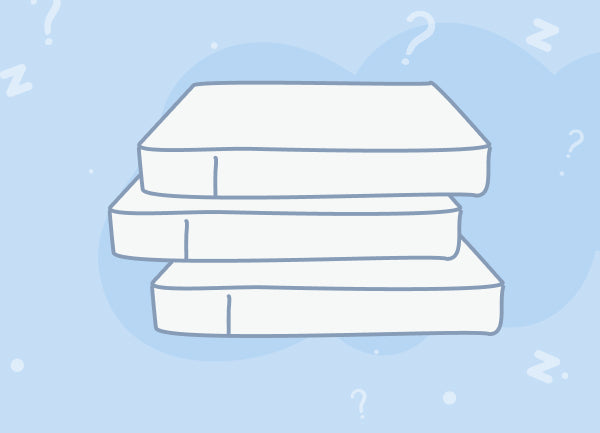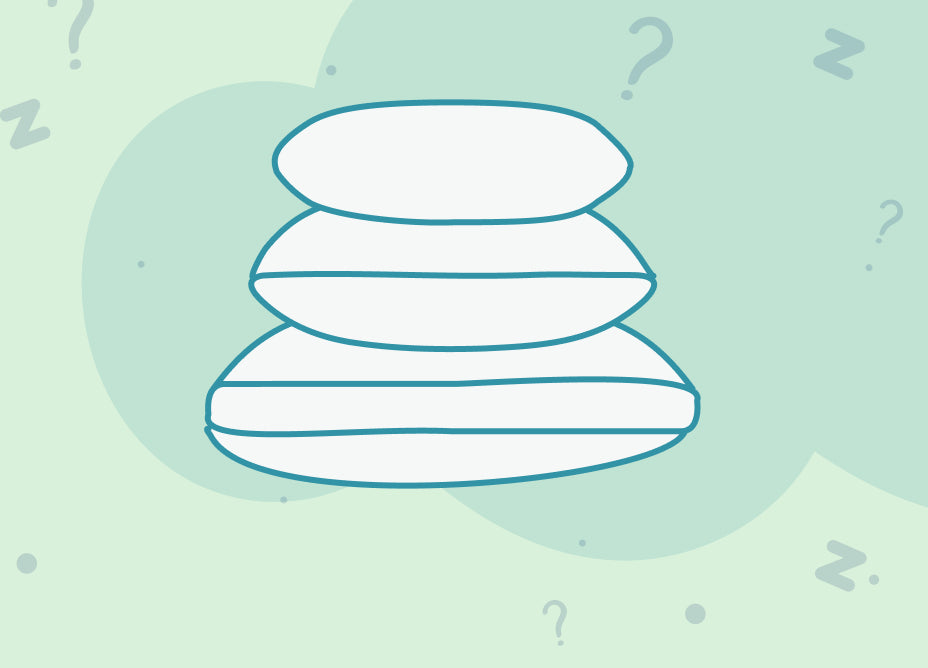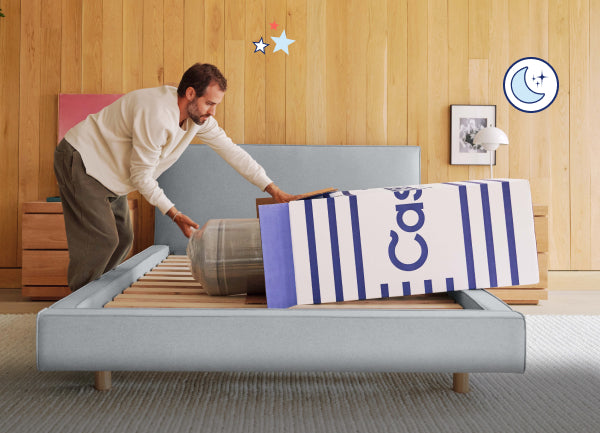Consider your child's age, development stage, sleeping habits, and bedroom size to figure out the right time. Then make the upgrade safe, smooth, and supportive of rest.
Upgrading from a toddler bed or crib to a twin is an exciting milestone for your little one. They can take pride in their big-kid setup, enjoy more space for their growing body, and possibly pick out new bedding.
But this milestone might not be something you want (or need) to rush. So, how do you know when the time is right? Keep reading for insight into when to transition from a toddler bed to a twin bed.
Understanding the Basics: Toddler Bed vs. Twin Bed
A twin bed is substantially larger than a toddler bed. Although most adults prefer something bigger, a twin is technically supposed to fit one adult of average height (and thus any child).
The sizes are the biggest differentiator, but twin and toddler beds also vary in terms of overall design, features, and value.
Size and Mattress Differences
Twin mattresses are 75 inches long and 38 inches wide. Twin XLs are the same width but 5 inches longer. Meanwhile, a toddler mattress is 52 inches long and 28 inches wide—the same size as a crib mattress, only used in a different bed frame configuration.
So, a standard twin bed provides an additional 23 inches of wiggle room the long way and an extra 10 inches from side to side.
If your child is currently in a toddler bed that was previously converted from a crib, switching to a twin will call for a new bed frame (or one passed down from an older sibling) and mattress, not to mention more floor space.
Get more details about the different sizes and tips for how to choose a mattress for a child.
Safety and Design Features
You'll also want to think carefully about safety features. Toddler beds typically have built-in rails on three or more sides to prevent littles from rolling out of bed. (The rails also make the bed look and feel more like a crib, helping younger toddlers when they make that transition.)
Twin beds vary in terms of design. Many twin frames have headboards, and you can find options with raised sides or guard rails, though this is less common. While most twin beds don't come with safety rails, you can sometimes buy safety accessories separately and attach them to the frame.
Twin mattress dimensions and heights also range. They can be low-profile beds, no wider or longer than the mattress itself (a space-saving option), or they can be taller (not recommended for this stage—more on this ahead). Opt for a twin-size bed that ensures comfort and fits into the room.
If your child's bedroom has enough floor space to fit a twin bed but is short on storage, think about getting them a storage bed frame with built-in drawers.
Longevity and Value
A modular crib-to-toddler bed can be a perfect first bed for your child, carrying them from the baby stage through the toddler years. But these frames don't last forever, and a three- or four-year-old could be nearing or surpassing the weight limit—most toddler beds have a 50-pound capacity.1
A high-quality twin bed can last much longer and "grow with your child." This bed size works for most kids, tweens, and even teenagers, though taller teens may eventually need a twin XL.
The point is, investing in a good bed frame and mattress can offer substantial value in the long run. Things can change, of course, but it might be the last bed you buy your child.
How to Know When It's Time to Upgrade
The right age or stage for one child to transition from a toddler bed to a twin isn't necessarily best for the next child. So, how do you know when to make the switch?
There are a few signs to look out for from your child:
- They're reaching the weight or size limit
- They seem uncomfortable while sleeping
- They're sneaking into your bed at night
- A new baby is on the way
- You're moving or redecorating
- They're asking for a big-kid bed
Keep in mind, the change can also affect other family members, the bedroom configuration, and your household as a whole. In the end, the switch from a toddler bed to a twin-size bed should make sense for everyone.
They're Reaching the Weight or Size Limit
As mentioned, most toddler beds max out around 50 pounds. You can check the specific model you have to see if the weight limit is higher or lower than that, but the U.S. Consumer Product Safety Commission says this type of bed isn't meant for children over 50 pounds.1
The average three-year-old is 32 pounds and 37 and a half inches tall. The average four-year-old child weighs 36 pounds and is 40 inches tall.2 But as parents know, all kids are different. These are just averages—it's a range.
This should go without saying, but a bed should be longer than the sleeper is tall. In other words, you want some wiggle room from top to bottom. So a 40-inch child could be getting too tall for their 52-inch toddler bed.
And if they exceed the weight limit, it could pose a safety risk. The bed could become wobbly at best. At worst, it could break and cause an injury. This clearly indicates your child is ready for a bigger, more stable bed.
They Seem Uncomfortable While Sleeping
A too-small bed can be uncomfortable for anyone, at any age. If your child is tossing and turning a lot at night, bumping into the rails of their toddler bed, or waking up frequently, they might need more space.
A twin could also help your kiddo stay warmer while sleeping. It can fit a larger bed cover (like a comforter or duvet) that covers their entire body, even as they move around during the night.

They're Sneaking into Your Bed at Night
Waking up at night is common among the five-and-under crowd. Many kids end up wandering into their parents' bedrooms, asking to be tucked back in, for a cup of water, or to sleep the remainder of the night in their parents' beds.3
A new bed may not automatically fix this—many factors can drive a child to wake up often and not want to sleep alone.4 That said, comfort plays a big role in kids falling asleep, staying asleep, and wanting to be in their own beds.5
A more spacious twin bed with new cozy bedding could make a difference.
A New Baby Is on the Way
The need to move a child up to the next bed tier could be influenced by the approaching arrival of a younger sibling. You might want to rearrange the bedrooms in your home or mentally prepare your child for their new role as an older sibling.
In any case, it's best to make the change a few months before the new baby comes so there's time to adjust. Another child will be a major change for the entire family, so settling into the twin bed beforehand can prevent overwhelm. If the due date is, say, three weeks from now, you might want to wait a few months after the baby is born and do the switch when things have settled down.6
You're Moving or Redecorating
Moving into a new home, redecorating your current space, or reassigning bedrooms can be an opportunity for a fresh start.
Research shows that adjusting habits and making lifestyle changes are more successful when done during life transitions.7 For a young child, this could be settling into a twin bed as part of the family's relocation or simply switching to a new bedroom.
They're Asking for a Big-Kid Bed
Your toddler might also start asking for a big-kid bed. This verbal readiness could be inspired by an older sibling's sleeping arrangement, a friend who recently graduated from a toddler bed, a storyline they saw on Cocomelon, or some combination of factors.

How to Make the Transition Smoother
Once you've decided upgrading your child to a twin bed is the right move, here's how to make the transition a smooth, positive, low-stress experience for everyone involved.
Let Them Be Involved in the Process
You might choose the actual bed frame and mattress based on price range, safety features, and quality. But letting your child pick out their bedding can get them excited about the process and give them a sense of ownership.
Explore Books and Videos About Big-Kid Bed Transitions
One perk of modern parenting is that there are virtually endless books and online resources to help young children with milestones and new experiences—the big-kid bed transition is no exception.
Books are great, and if a little screen time is OK, there's a good chance one of your child's favorite shows has an episode on this exact topic.
You can also explain the perks of a bigger bed, like that a parent can fit next to them for story time and more room for stuffed animals.
Set Expectations Around Safety and Behavior
Communicate to your child that a bigger bed might give them more freedom, but it doesn't mean they can get out of bed before morning. Stick with the same bedtime and before-bed routine, at least at first, to help with the transition.8
You might also want to make clear that jumping on the bed isn't allowed.
Add Bed Rails, Choose a Low-Profile Frame, or Start with the Mattress on the Floor
Depending on your child's age and sleeping habits, consider adding rails to their twin bed to prevent them from rolling off the edge.
A low-profile bed frame or even temporarily starting with the mattress directly on the floor can also be a good option.9 Preventing falls should be a priority, of course, but this could at least minimize it to a very short drop onto a carpeted floor.
Secure the Bed Against the Wall
You might also be able to secure the twin bed frame against the wall. This can prevent rolling off on at least one side or a child getting trapped between the bed and wall.6
Avoid Tall Frames or Raised Beds at First
Tall frames, raised beds, and bunk beds (particularly the top bunk) generally aren't recommended for younger children. In the event of a fall off of a taller bed, the drop is longer and more likely to cause an injury.6
Keep the Sleep Area Clutter-Free
Keep the surrounding bedroom area clutter-free as much as possible. In case your child does get up in the night, this can limit trips and falls when walking in the dark.
Choosing the Right Twin Mattress for Growing Kids
Kids don't generally need the thickest, fanciest mattress. But support, firmness, and durability still matter—a high-quality twin mattress could last through the teen years.
Some kids might like the cushy feel of a super-plush mattress, but medium to medium-firm might be best in terms of support.10 Memory foam mattresses, like The One, are often the most affordable and work well for children. Hybrid mattresses (combining innersprings with foam) can also be good options if you want the next level up.
Make the Leap with Casper
When to transition from a toddler bed to a twin bed is different for every family. But once the right time comes, Casper can help you make the leap.
Check out our twin bed frames, compare mattresses and bed sheets, and get our thoughts on what type of pillow is best for your child.
Sources:
- United States Consumer Protection Safety Commission (CPSC). Toddler Beds. https://www.cpsc.gov/FAQ/Toddler-Beds
- Cincinnati Children's Hospital Medical Center. Growth, Range of Height and Weight. https://www.cincinnatichildrens.org/health/g/normal-growth
- Michigan Medicine. Bedtime battles: 1 in 4 parents say their child can't go to sleep because they're worried or anxious. https://www.michiganmedicine.org/health-lab/bedtime-battles-1-4-parents-say-their-child-cant-go-sleep-because-theyre-worried-or-anxious
- Journal of Abnormal Psychology. Co-Sleeping among School-Aged Anxious and Non-Anxious Children: Associations with Sleep Variability and Timing. https://pmc.ncbi.nlm.nih.gov/articles/PMC6033696/
- Journal of Family Psychology. The Physical Home Environment and Sleep: What Matters Most for Sleep in Early Childhood. https://pmc.ncbi.nlm.nih.gov/articles/PMC9747092/
- St. Louis Children's Hospital. Tackling the Toddler Crib-to-Bed Transition. https://www.stlouischildrens.org/health-resources/pulse/tackling-toddler-crib-bed-transition
- Current Opinion in Behavioral Sciences. Habit formation and change. https://www.sciencedirect.com/science/article/abs/pii/S2352154617301602
- Stanford Health. From the crib to the bed: How to transition your child. https://news.sanfordhealth.org/childrens/crib-bed-transition-child/
- The New York Times. Is Your Toddler Ready for a 'Big Kid Bed'?. https://www.nytimes.com/article/crib-to-bed.html
- National Center for Biotechnology Information (NCBI). A firm recommendation: measuring the softness of infant sleep surfaces. https://pmc.ncbi.nlm.nih.gov/articles/PMC8436463/











